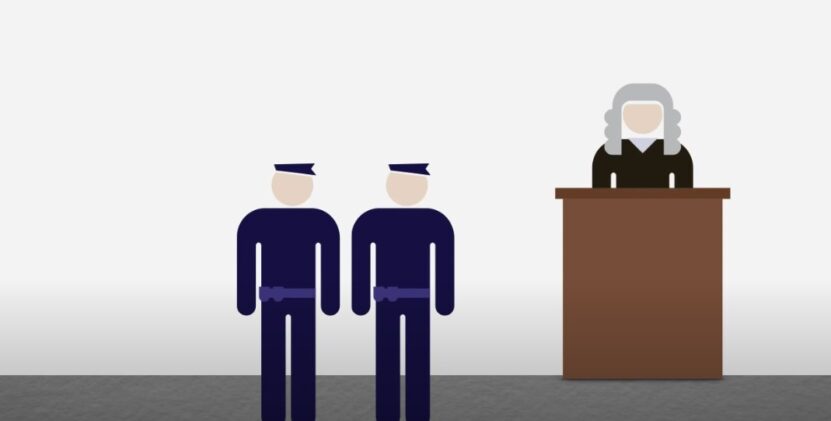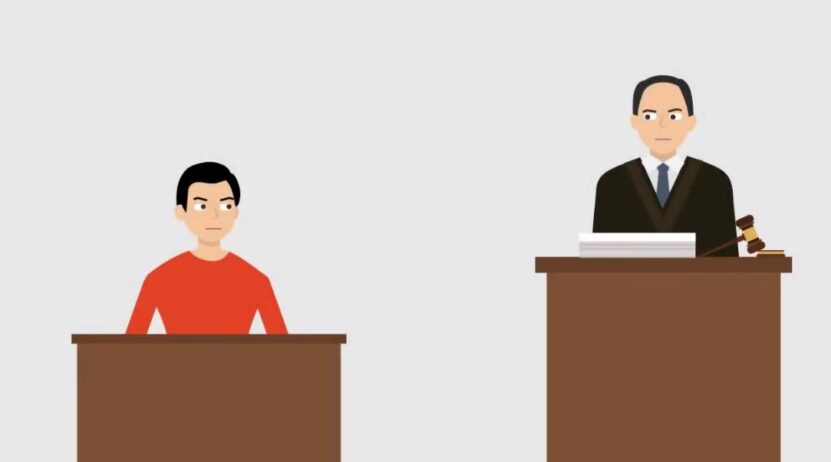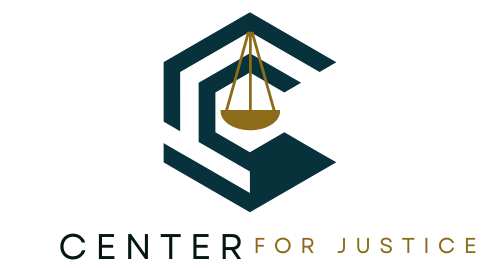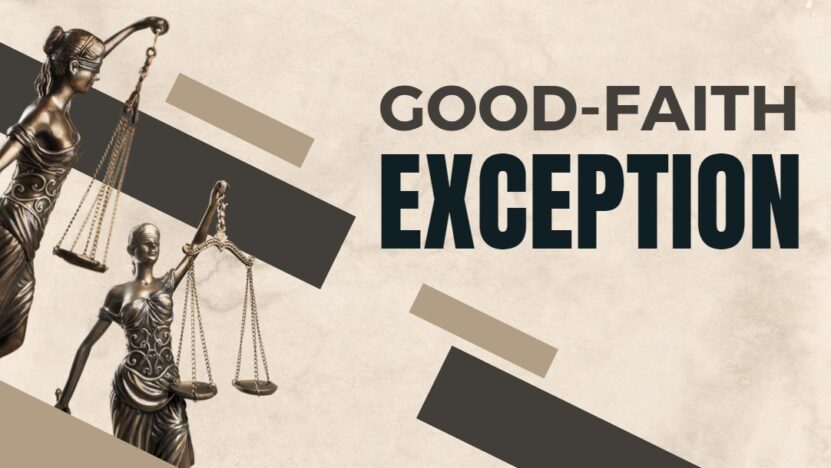I’ve often been intrigued by the delicate balance our legal system maintains between individual rights and societal order. The interplay of these forces frequently finds a focal point in good faith Exception—a critical, yet often misunderstood, facet of American jurisprudence. It serves as a testament to our constant endeavor to define and redefine the boundaries of law enforcement authority in relation to the private rights of citizens.
In the crucible of the courtroom, the Good Faith Exception comes to life. It shapes decisions, influences outcomes, and, at times, tips the scales of justice. The concept originates from the Fourth Amendment, which protects against unreasonable searches and seizures. It allows evidence obtained in violation of this right to be admitted in court if law enforcement acted with ‘good faith,’ believing their conduct to be lawful, and today, we will discuss it.
The Fundamentals of Good Faith Exception
The Good Faith Exception is a legal concept that emerges from the Fourth Amendment of the United States Constitution, which guards citizens against unreasonable searches and seizures. This rule permits evidence obtained in violation of a person’s constitutional rights to be used against them in a court of law if the law enforcement officer acted with objective good faith and a reasonable belief that they were following the law.
This rule is not without controversy, however, as some argue it provides a loophole for potential abuses of power. The principle was first established in the landmark 1984 Supreme Court case, United States v. Leon, which upheld the admissibility of evidence obtained in a search with a warrant later found to be invalid. This ruling was made on the basis that the police had relied in “good faith” on the warrant’s legality.
Origins and History
The concept of Good Faith Exception has a robust history. The U.S Supreme Court, in United States v. Leon (1984), set a precedent when it ruled that evidence seized on the basis of a mistakenly issued search warrant could be used in court. This fundamentally shifted the nature of the exclusionary rule, which had previously prohibited the use of unlawfully obtained evidence.
The Court determined that if law enforcement acted in the honest belief that their actions were lawful, the aim of deterring police misconduct would not be furthered by excluding the evidence. This ruling, however, has ignited a debate that continues to this day about the balance between the need for effective law enforcement and the necessity to protect citizens’ Fourth Amendment rights.
The Good Faith Exception and the Exclusionary Rule

The Good Faith Exception serves as a counterbalance to the Exclusionary Rule.
This rule, established in the case Weeks v. United States (1914), states that any evidence obtained in violation of the Fourth Amendment cannot be used in federal court. The Mapp v. Ohio (1961) case later extended this rule to state courts.
However, the Good Faith Exception provides a significant exemption to this rule. When an officer acts with a reasonable belief that their actions are within the boundaries of the law—even if it later turns out they weren’t—any evidence obtained may be admissible in court. The Exclusionary Rule and the Good Faith Exception thus work together in a complex dance that continues to shape American jurisprudence.
The Key Factors of the Good Faith Exception
There are three critical components in the application of the Good Faith Exception:
- Reliance on a search warrant: If law enforcement acted on a warrant they believed to be valid but was later proven to be deficient in some way, the evidence might still be admitted.
- Reliance on a statute or ordinance: The Good Faith Exception applies if the police acted according to a law or ordinance that was later deemed unconstitutional.
- Reliance on court records: If officers act based on court records that contain errors not of their own making, any evidence obtained may still be considered under this exception.
Challenges and Critiques

Critics of the Good Faith Exception argue that it undermines the Exclusionary Rule and weakens Fourth Amendment protections. They contend that it can provide a veil of immunity for law enforcement misconduct and muddies the boundaries of what is considered a “reasonable” mistake.
They further argue that it places an undue burden on citizens to know and understand the law in a way that even trained law enforcement officers might not. Furthermore, there’s concern that it might incentivize police departments to inadequately train their officers, thereby increasing the likelihood of “reasonable” mistakes.
Defenses of the Good Faith Exception
Advocates of the Good Faith Exception, on the other hand, argue that it is necessary for effective law enforcement. They maintain that it provides a balance to the Exclusionary Rule, which can otherwise obstruct justice by excluding relevant evidence due to procedural errors that did not significantly invade a person’s privacy.
They also argue that the Good Faith Exception encourages law enforcement to act responsibly, as it only applies when officers have a reasonable belief that their actions are lawful. It doesn’t protect officers who knowingly or recklessly violate the law.
Good Faith Exception vs. Qualified Immunity
It’s important to differentiate between the Good Faith Exception and another often misunderstood legal concept: Qualified Immunity. Qualified Immunity shields government officials from being held personally liable for constitutional violations—like the right to be free from excessive police force—unless they violated a “clearly established” law.
Unlike the Good Faith Exception, Qualified Immunity is more focused on civil lawsuits rather than the admissibility of evidence in criminal cases. While both concepts share some similarities—such as shielding individuals acting under the color of law from certain consequences—they operate in distinct legal arenas and serve different purposes.
Good Faith Exception in Different Jurisdictions
Not all states follow the Good Faith Exception as outlined by United States v. Leon. Some, like Massachusetts and New York, do not apply the rule, emphasizing instead a stricter interpretation of the Exclusionary Rule. These jurisdictions maintain that any evidence obtained from an unlawful search—regardless of the officer’s subjective belief—must be excluded.
Other states, such as California, have adopted the Good Faith Exception but with modifications to fit within their specific legal frameworks. It’s important to consult local laws to fully understand the applicability of this doctrine in different areas.
Key Cases Illustrating the Good Faith Exception
There are a number of important cases that have shaped the Good Faith Exception over the years, beyond the foundational United States v. Leon. For instance, Illinois v. Krull (1987) expanded the rule to include searches conducted in “reasonable reliance” upon a statute later found to be unconstitutional.
In Arizona v. Evans (1995), the Supreme Court ruled that the Good Faith Exception could apply even if the error leading to the unlawful search was due to the negligence of court employees. These cases and others continue to shape the contours of the Good Faith Exception in modern jurisprudence.
What Future Holds
The future of the Good Faith Exception remains uncertain. As society and technology evolve, so too do our concepts of privacy, reasonable search, and seizure. As a result, the application of this doctrine will continue to be tested in new contexts.
This ongoing legal evolution will no doubt see new challenges, interpretations, and perhaps even expansions of the Good Faith Exception. For now, we can only wait and watch as the nation’s highest courts continue to grapple with these issues.
Practical Implications of the Good Faith Exception
The Good Faith Exception has considerable practical implications for both law enforcement and citizens alike. For the police, it provides a degree of flexibility when carrying out their duties, while for citizens, it serves as a reminder of the need to be knowledgeable about one’s rights.
- For law enforcement: Understanding the scope and limitations of the Good Faith Exception is crucial for carrying out duties within the bounds of the law and maintaining the admissibility of collected evidence.
- For citizens: Awareness about the Good Faith Exception and its implications can empower individuals to better protect their rights and effectively interact with the legal system.
Teaching the Good Faith Exception in Law Schools

The Good Faith Exception is a critical part of any law school curriculum. It’s essential for budding legal professionals to understand the complexities of this doctrine and how it intersects with other principles like the Fourth Amendment and the Exclusionary Rule.
Simulated court cases, in-depth study of precedents, and engaging classroom discussions are all part of how this complex topic can be made accessible to law students. Regardless of their future specialization, understanding the Good Faith Exception will be instrumental in their legal career.
In addition to discussing the “Good Faith Exception” and its impact on criminal cases, the article also explores Florida’s unique legislation pertaining to age of consent exceptions, commonly referred to as the “Romeo and Juliet” law.
Final Words
The Good Faith Exception is a vital component of U.S. law, serving as a counterpoint to the Exclusionary Rule and enabling the legal system to strike a balance between upholding constitutional rights and maintaining effective law enforcement. As our society continues to evolve, it is inevitable that our understanding and application of this doctrine will evolve as well.
While this doctrine is complex, understanding it can provide valuable insights into the U.S. legal system. We have explored the history, applications, criticisms, and future implications of the Good Faith Exception. But the exploration doesn’t stop here; it merely provides a starting point for further discourse on this fascinating legal topic.

